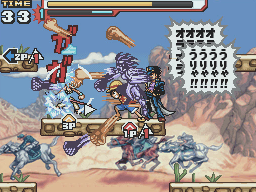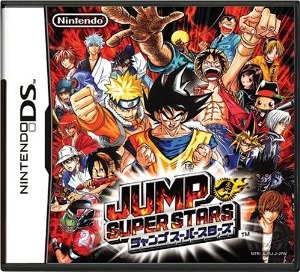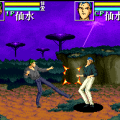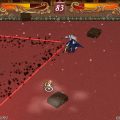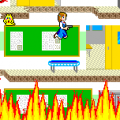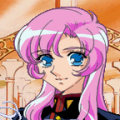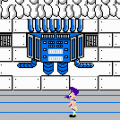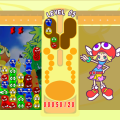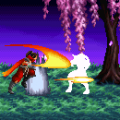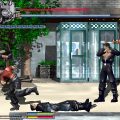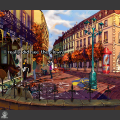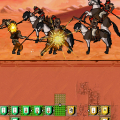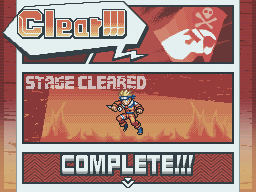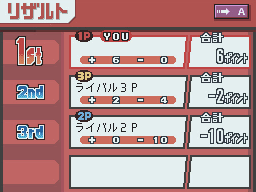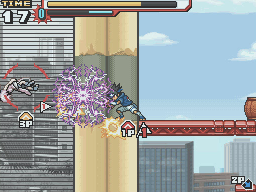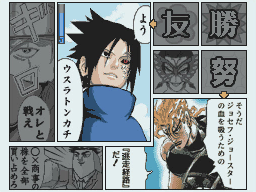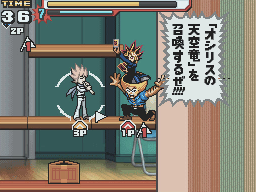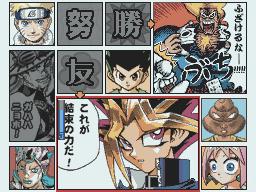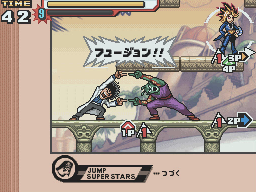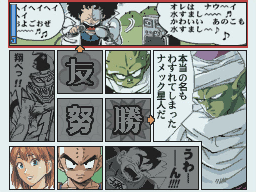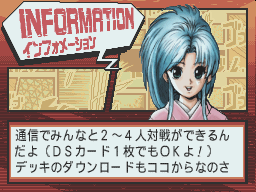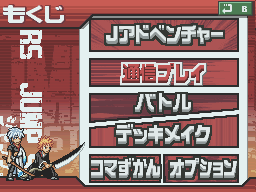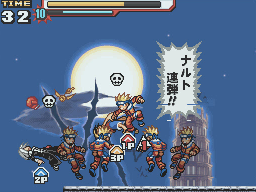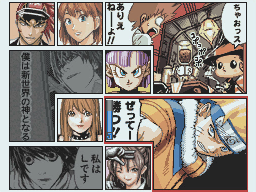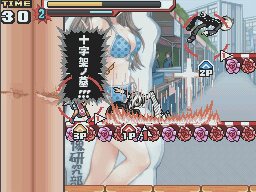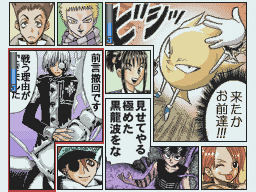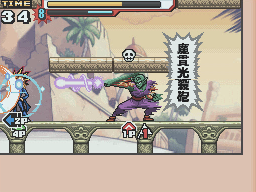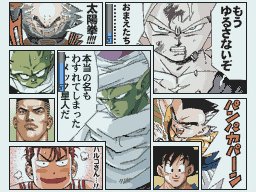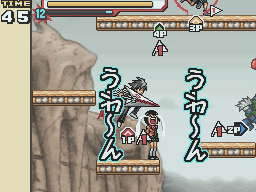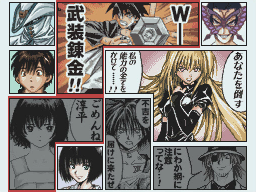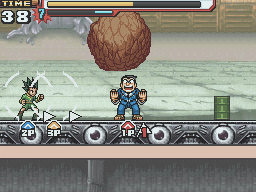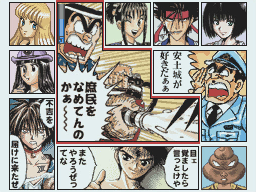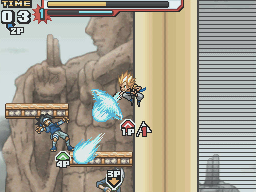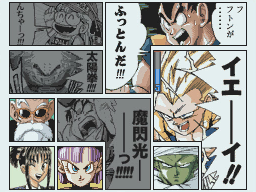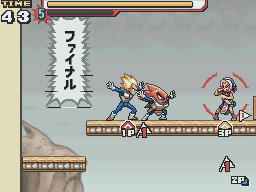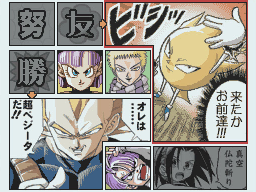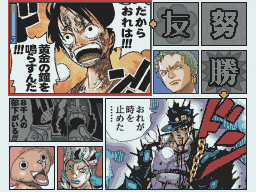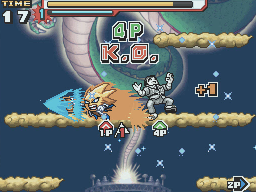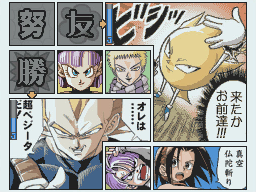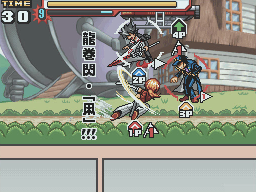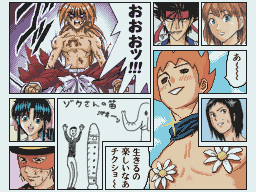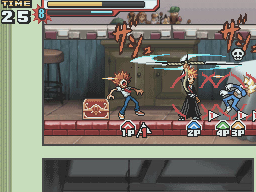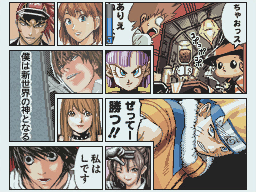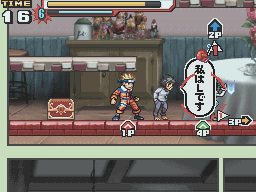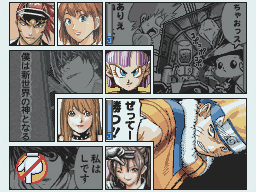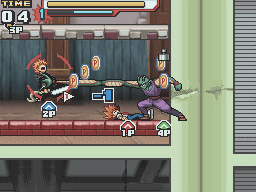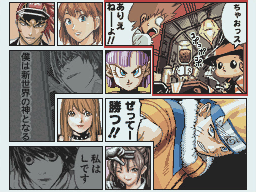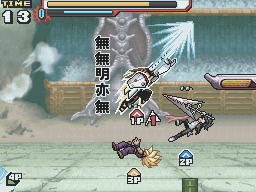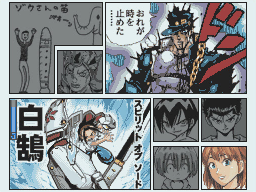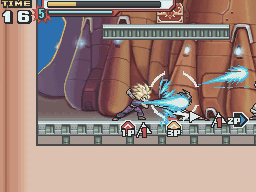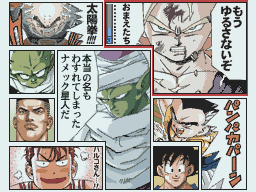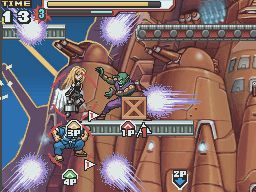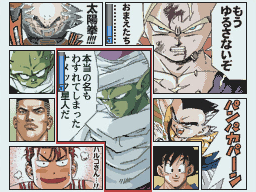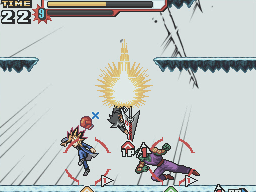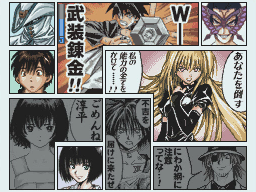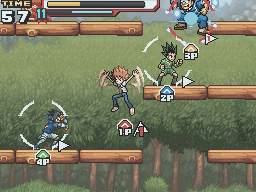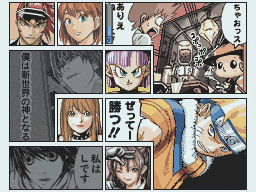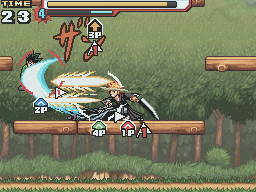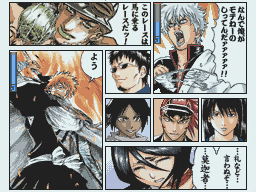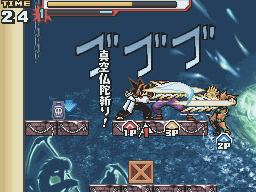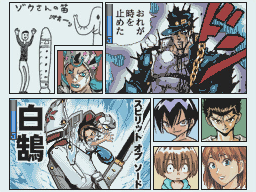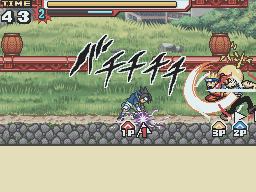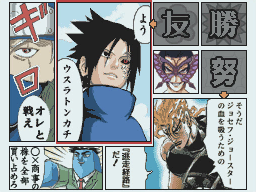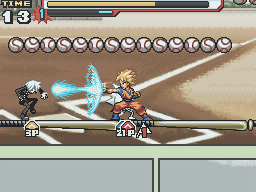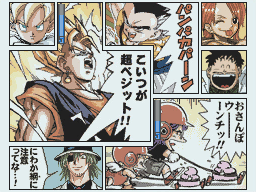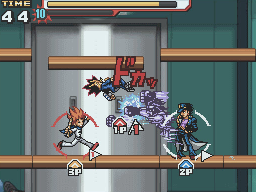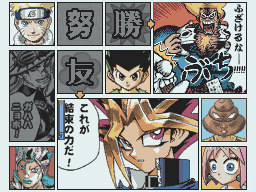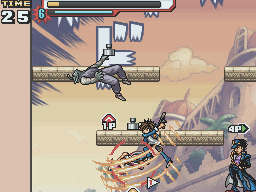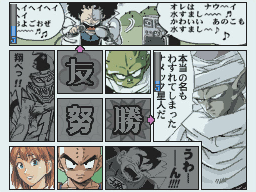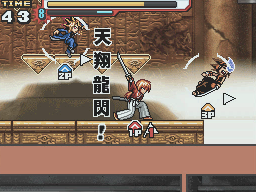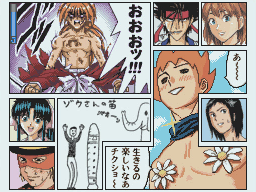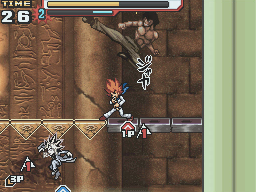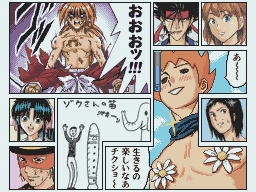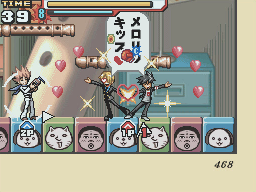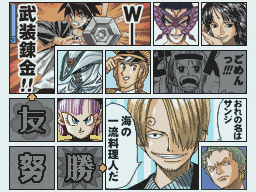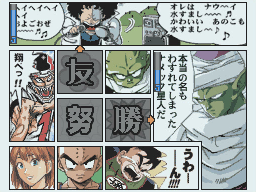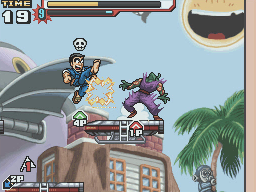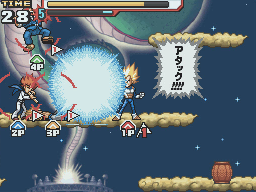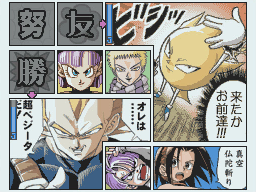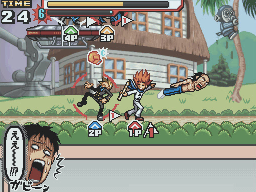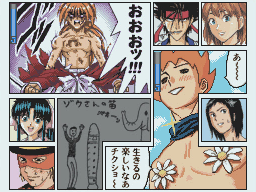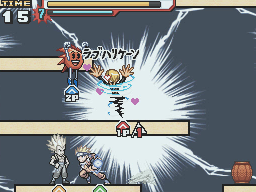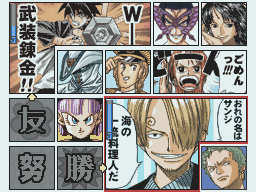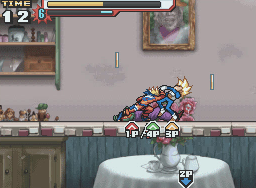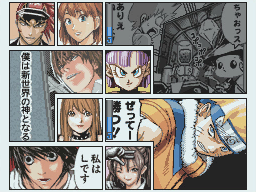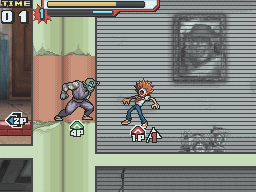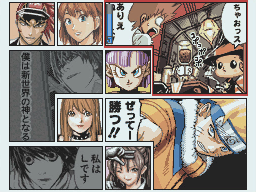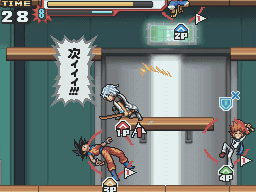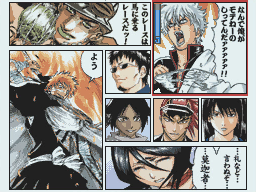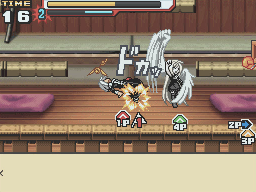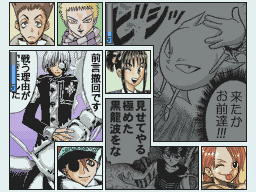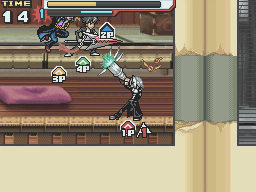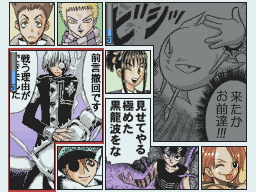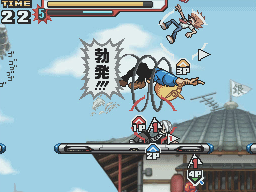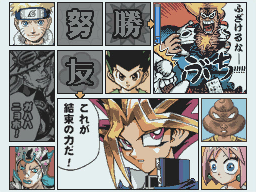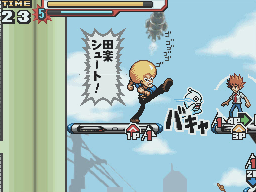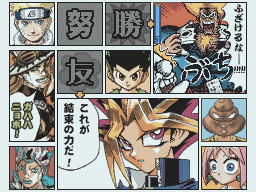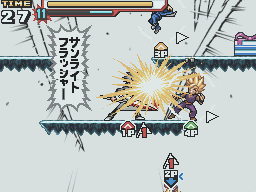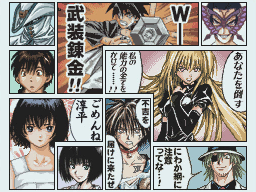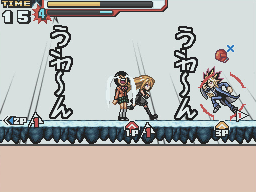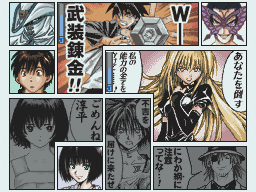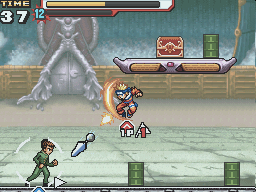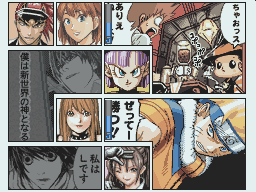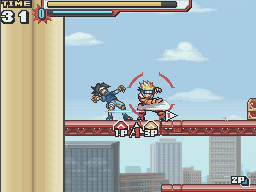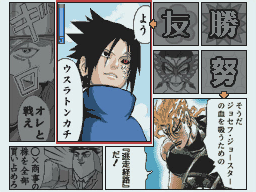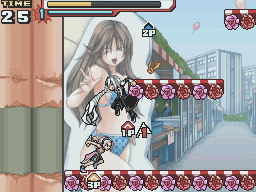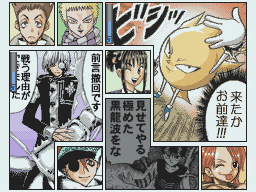- Jump Super Stars
- Jump Ultimate Stars
A good licensed game has to fulfill two separate objectives: it needs to be a good game and it needs to be a good use of the license. This gives them double the opportunity for failure. However, it also gives them double the opportunity for success.
Jump Super Stars and Jump Ultimate Stars are a pair of multiplayer fighting games based on series from Weekly Shōnen Jump, a long-running manga anthology. “Shōnen” refers to the magazine’s target audience: teenage males. However, many of the franchises that originate on its pages appeal to a wider and more varied audience. The games were successful among importers as well as locally, largely because of the international popularity of the featured series. More importantly, they offer a great multiplayer experience and plentiful content. While longtime fans get the most out of the game, even gamers with no interest in manga have something solid to find.
The two games are commonly compared to theSuper Smash Bros. series. In fact, the influence of Nintendo’s series can be found in many ways. Both are four-player crossover fighters with multi-platform stages and simple controls. Both use combinations of direction input and an attack button to select between different attacks rather than the command inputs pioneered by Street Fighter. Games generally operate on rules similar to Super Smash Bros.‘s Time mode, though there is also an elimination mode and something resembling Mario Kart: Double Dash!!‘s Shine Thief.
Despite this similarity, the Jump games have several attributes that make them distinct from the Super Smash Bros.series. Their combat is closer to that of a traditional fighting game without strongly resembling one. The player has a health bar and is temporarily knocked out when it is depleted. They also have a super meter which is filled by hitting by enemies, being hit by enemies, and collecting the coins ejected from fallen enemies. The super bar can store multiple stocks. Players are not knocked back further when their health is low, but their colour drains, encouraging other players to move in for the kill. Ring outs are a possible method for a quick kill, but for many stages this requires breaking the walls first. While items are present, they provide health refills and temporary buffs; the bomb is the only one that can be used as a weapon.
The largest distinguishing feature of the two games is found on the bottom screen. In the games’ single player mode, the player collects manga panels, or Koma, much resembling Tetris blocks. These Koma are then placed on the 5×4 grid on the bottom screen to provide different options during battle. The result is that the Jump games have a similar appeal to collectible card games. Players can easily sink large amounts of time into building multiple decks, whether for serious play or just to try out all the things that game has to offer.
Despite an extremely easy AI, the allure of unlocking new Koma makes single player more compelling than that of most fighting games. The limited size of the decks creates more gameplay depth than could otherwise be found in the simplistic fighting mechanics. Choosing larger, more powerful Battle characters restricts the selection of Support characters available, for a simple example.
There is also an element of stealth – something very unusual for a fighting game and largely a result of the game’s platform. Since the screen is small and multiplayer on the DS is always wireless, the screen follows the player’s character instead of scaling to match the distance between players. There is only a pointer to indicate the other players’ locations off-screen. Some characters have attacks with enough range to launch a surprise attack from this large semi-blind spot, while others have moves that leave them wide open and are best done while hiding. The other players’ bottom screens are also secret, so no one has an idea about the contents of their opponents’ decks or their special moves until they actually start using them. It’s a unique experience when a friend first uses a powerful new Koma that you have never seen and don’t know how to deal with.
While canned combos are possible, combos in general tend to be simple and without fanfare. The recipient of a combo can even break out with use of the right Koma. The games are more geared towards the careful use of attacks and the super meter. Players naturally seek each other out, so learning how to strike into a crowd is important. While the games are not grossly unbalanced, there are certain overpowered Koma. The lack of chipping damage can lead to turtling tactics.
The Jump games are at their weakest in one-on-one matches and are not as well suited to competitive play as traditional fighting games. However, they provide a hectic, fun multiplayer fighting game with depth and longevity. Few games have been so successful in that niche.
In order to understand the deck-building aspect of Ganbarion’s Jump games, one must understand the Koma that make up the decks. There are three usable types in both of games. A Koma’s categorization is based on size; most characters have Koma of different sizes, and thus can be used in different ways, but a single character can only appear in a deck once.
Help Koma are only one block in size. When clicked, they provide the player’s character with a buff in exchange for one stock of the super meter. For example, they may heal your character or provide temporary invincibility or invisibility. A select few have a passive effect instead, and so are not subject to this problem. Since only one status effect can be applied at a time, a wide variety of Help Koma is not immensely useful in and of itself.
Support Koma range from two to three blocks in size. Since only one Koma of any given size is available for each character, each character can only have two possible Support Koma. At the cost of one stock, a Support Koma will summon the character to perform some sort of attack or ability. Many Support Koma place temporary debuffs on opponents if the attack lands. Some of these are quite brutal, such as disabling normal attacks or blanking the opponent’s main screen. However, only one debuff is allowed at a time and some Help Koma cure all status effects, so Help Koma and item boxes are easy counters.
Battle Koma range from four to eight in size. Since they’re so large and Koma cannot be rotated, players will often find themselves building a deck around a desired character. There is no character select in Ganbarion’s Jump games; clicking Battle characters in the deck takes that role. Koma of increasing size provide the character with a larger health bar and different – although not necessarily better – super attacks. Each has their own health bar and recovers slowly when not currently in play. If all the Battle characters in a deck are KOed in a Time game, the player loses an additional point, so the player is encouraged to choose multiple characters that complement each other.
Even if you don’t feel like experimenting with Help and Support Koma, there is a simpler way to use them. Each Battle character receives a boost to their maximum health if certain other characters are placed adjacent to them. If the boosting character is a Support or Battle character, there is also a boost to the maximum special meter, which is shared for all characters in the deck. This maximum can be increased by well over a dozen. This is also a good way to get value out of space that you would otherwise not use.
There are additional concerns when selecting playable characters for a deck beyond just which you like best. Battle characters come in three types themselves: Power, Knowledge, and Laughter. Each type deals extra damage to the next in standard rock-paper-scissors mechanic fashion. While it might seem obvious to have one battle character of each type, that would also limit the size of the characters you could use. These mechanics increase the depth of deck building and gently discourage players from sticking to just one favourite character.
The story mode consists of several sets of missions, something like the single-player modes found in the Soul Caliburfranchise. The goal is not necessarily just to defeat the enemies. It’s a bit tricky to complete the game without knowledge of Japanese or a guide because of this. The tutorial is simple and is not extremely long, but the amount of text may be intimidating and the player should still be looking for button prompts. The player will also likely struggle to figure out the effects of many Koma if they don’t use the guide. But the game can still be completed in full if the player makes an effort to figure the different mission conditions out.
While many of the conditions for a stage are optional, clearing them unlocks additional Koma. One-block Koma can be used as-is, but players have to first insert the appropriate one-block character into larger, incomplete Koma – called a Serif Koma – in order to permanently transform them into their usable form. It’s not so bad if you are familiar with the appropriate manga series, but it’s pointless tedium if you are not. This is easily the game’s worst feature, though it obviously ceases to be a problem when all the Koma have been prepared.
Another flaw with the game is the stage design. All of the stages in the game are rather plain. Perhaps their unanimated background is inspired by a certain manga, but their unique gameplay features are pretty boring – there are slippery stages, moving platforms, conveyor belts, nothing you haven’t seen before. It doesn’t compare to Super Smash Bros. at all in that regard. There are certainly many players who prefer their fighting game stages without “gimmicks”, but variety can be good thing as well.
While the super moves are distinctive, the playable characters don’t seem to be designed for a particular style of play as often as in traditional fighting games, perhaps due to the games’ pick-up-and-play nature. Still, many of the characters’ normal attacks have properties that differentiate them and make it worthwhile to learn them individually.
For example, some characters have pummelling attacks that are great when enemies bunch up. Others have projectiles or rushing moves. Some attacks can be powered up or holding down or mashing the attack button. Some characters have more unique attributes to their attacks, like Dio’s HP stealing grab or Gotenks’ binding rings.
While the game implements many different series, it handles them all with care. The smallest Koma feature only a character’s mugshot, but all of the rest are taken straight from the pages of the manga. Almost all of the characters’ attacks are also directly inspired by events and images from the manga. It’s a delight for fans to see an iconic or memetic scene recreated with a special move or summoned character. While the different series feature different art styles, they are all appear here with small, almost cute sprites, so the game does not feel visually jarring as a result.
Another interesting element of fanservice, if often an impractical one, is the Tag Attack. By connecting two characters with a set of three one-block Koma, the player can unleash a simultaneous attack with the two characters. What’s more, a unique special move is executed if certain pre-defined pairs are used. These moves are usually pretty clever. Some characters will combine similar attacks, such as Goku and Naruto’s signature energy blasts. Others play with the characters for humour, such as Kakashi introducing Gintoki to his erotica. One stand-out is Yugi and Bobobo: their combination attack was originally a cameo in the Bobobo manga. Unfortunately, this feature is absent in the sequel.
There are over 400 Koma usable in the game, and 34 distinct playable characters. Featured series without playable characters are Eyeshield 21, Strawberry 100%, Slam Dunk, Death Note, The Prince of Tennis, Hikaru no Go, and Mr. Fullswing.
Characters
Sawada “Tsuna” Tsunayoshi (Reborn!)
Laughter-type. This cowardly loser is next in line to become the head of the world’s most powerful mafia family. Luckily, his infant mentor Reborn can bring out his inner superman by shooting him with special bullets. Tsuna compensates for his weak normal attacks with the strength of his super attacks.
Gintoki Sakata (Gin Tama)
Laughter-type. Once a samurai fighting against the alien invasion of Edo, Gintoki is now a freelancer. Despite being lazy and ill-mannered, he still uses his peerless swordsmanship to protect others. Gintoki’s attacks are actually a little visually deceptive. It’s easy to mistake the direction that he will hit.
Kankichi Ryotsu (Kochira Katsushika-ku Kameari Kōen Mae Hashutsujo)
Laughter-type. Ryotsu is a middle-aged man looking to get rich through the day’s latest fads. Though he is a police officer by occupation, he doesn’t have any desire to do his job. Ryotsu’s damage isn’t great, but his health is higher than most.
Asakura Yoh (Shaman King)
Laughter-type. Controlling the world is the prize for winning the Shaman Fight, and the unenthusiastic Yoh is training to win. He prefers the company of spirits over people. Players can easily deliver debuffs with some of his special attacks.
Also appearing is his fiancée: Kyouyama Anna.
Jotaro Kujo (JoJo’s Bizarre Adventure)
Power-type. A rowdy high school student who fights with his humanoid psychic projection. He has a sharp mind and doesn’t waste energy. Jotaro is slow, but his attacks can deal heavy damage and are fantastic when enemies are bunched up.
Also appearing is the vengeful vampire: Dio Brando.
Allen Walker (D. Gray-man)
Knowledge-type. The Black Order is a religious organization that fights the Akuma, monsters made from human souls. Allen’s cursed eye and deformed arm allow him to serve as an Exorcist for the Order. He has nice ranged abilities, but also a lot of knockback.
Arale Norimaki (Dr. Slump)
Laughter-type. Norimaki Senbei built a hyper-intelligent, super-strong robot girl and adopted her. Despite that, she’s extremely nearsighted, childish and has a quirky personality. Arale can put the pressure on opponents by throwing poop around. It’s not as gross as it sounds.
Also appearing is the mad scientist: Dr. Mashirito.
Son Goku (Dragon Ball)
Power-type. Goku is a martial artist on a lifelong quest to pursue greater strength. If you’re the type of person to read this website, there’s a very good chance that you’ve heard of this guy. Goku is a fairly balanced character, leaning more towards speed. In distinctive Dragon Ball Z fashion, he can knock an enemy into the air, appear above, and smash him back down.
Also appearing are his comrades: Piccolo, Son Gohan, Vegeta, and Gotenks.
Naruto Uzumaki (Naruto)
Power-type. Naruto spent his childhood as a target for resentment because of the destructive beast sealed inside of his body. He is both mischievous and self-confident. As expected of a ninja, Naruto is naturally pretty quick, but he’s still one of the more balanced characters.
Also appearing are the other members of Naruto’s team: Sasuke Uchihara, Sakura Haruno, and Kakashi Hatake.
Gon Freecss (Hunter × Hunter)
Power-type. Hunters are members of an elite organization that deals in everything, and Gon plans to become one. He is far tougher than he looks, but is still rather naïve and sincere despite the hostile world around him. Gon can charge up the power of his energy-based attacks.
Jaguar Junichi (Pyuu to Fuku! Jaguar)
Laughter-type. Playing the recorder is the life’s mission of this weird young man. He tends to suck the people around him into his quest to proliferate the instrument. Some of his specials let him play his recorder to get a bonus. He can even get a point by doing so, as if he had just KOed an opponent.
Muto Kazuki (Buso Renkin)
Power-type. After being killed by a man-eating Homunculus, Kazuki is brought back from the dead and decides to fight against them. The Kakugane, a device made by alchemists, used to materialize his weapon also replaces his damaged heart. His moveset largely consists of dashing attacks, albeit in different directions.
Eve (Black Cat)
Knowledge-type. A certified bounty hunter. As a clone made with nanomachines, she transform her hair or other body parts to use as a weapon. She’s one of the few characters that can triple jump.
Kurosaki Ichigo (Bleach)
Power-type. A young man working as a substitute Shinigami, a psychopomp that protects good souls from corrupted ones. His mother was killed by a Hollow; a corrupted soul. Ichigo swings his sword in wide arcs and can do a lot of damage, but some attacks can leave him open.
Bobobo-bo Bo-bobo (Bobobo-bo Bo-bobo)
Laughter-type. A vigilante fighting against the Maruhage Empire with the powers of nosehair and confusion. Nothing he says and very little that he does make any sort of sense. Deals heavy damage – and since Power-types are notably more common than others, it’s more valuable than you’d think.
Also appearing is his ally: Poppa Rocks.
Yugi Mutou (Yu-Gi-Oh!)
Knowledge-type. A boy who loves traditional games: the types with boards or cards or dice. After solving an ancient Egypian puzzle, troubled times find him possessed by the brilliant but brutal mind of an ancient Pharaoh. Yugi’s summoning moves let him throw out attacks from just out of the opponent’s reach.
Yusuke Urameshi (YuYu Hakusho)
Knowledge-type. Power-type. In an attempt to save a child from an oncoming car, a teenage delinquent is killed. After being returned to life, he finds himself as the only human able to fight evil demons from the Spirit World. Yusuke’s special attacks are powerful, but they must be charged for full effect.
Himura Kenshin (Rurouni Kenshin)
Power-type. An assassin during the political turmoil of Japan in the 1860s. Kenshin has since given up killing: his sword has the edge on the reversed side to keep his attacks non-lethal. Both Kenshin’s attacks and Kenshin himself is quick.
Monkey D. Luffy (One Piece)
Power-type. A noble pirate. After eating a magical fruit, his body turned into rubber. With his elastic limbs, Luffy has lots of moves with range. He can also aim in many different directions with his attacks, so he can play keep-away.
Also appearing are the rest of his crew: Roronoa Zolo, Nami, Sanji, and Nico Robin.
Links:
Official Jump Super Stars site Japanese only.
Official Jump Ultimate Stars site Japanese only.
English patch’s website Now defunct, though the patch can be found elsewhere. The patch is complete. There are versions with and with and without translated panels. (Archived in the Wayback Machine.)
